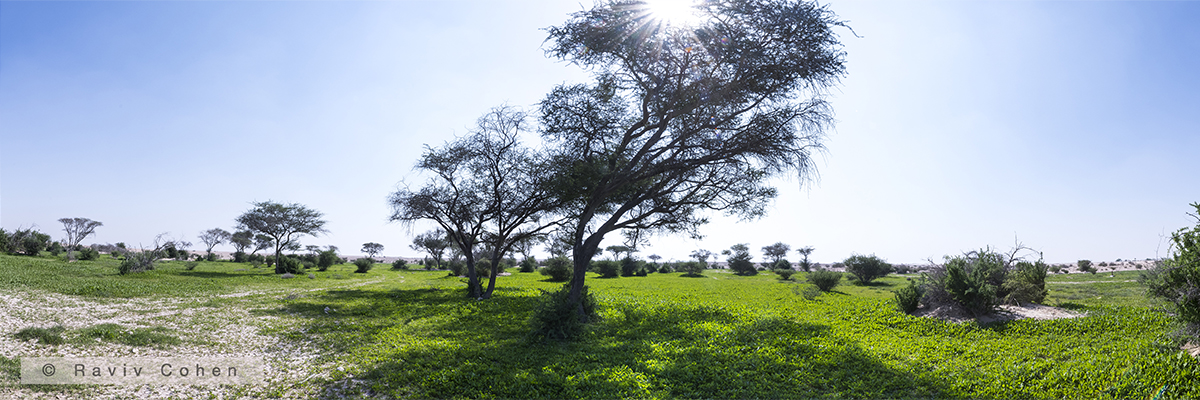
(sing. Rawda or Rodah) / (Karst features)
Rawda in Arabic means garden, meadow or fertile depression. Geologically, rawdat along with sinkholes, caves and solution hollows, are karst features, and provide evidence of a wetter Arabia. Karst forms from the dissolution of carbonate rock by circulating groundwater, which in Qatar, left behind caves in the limestone. With time, cave openings are created, then caves get filled with aeolian sand and alluvial soils, and when the arch opening collapses, a rawda or a sinkhole is created.
Rawda is lusciously-green and most productive after the winter rains when the understory annuals emerge, and brown, cracked and dusted during summers. Rawda receives only ephemeral surface water, contrasting oases, receiving a constant supply of water. Flows from direct rainfall, runoff from uplands, and from runnels, transport soil particles, rocks and nutrients that accumulate in the depression providing for denser plant and faunal assemblages. Biocrusts, often covering inter-plant spaces, turn green from brown after the rains, stabilizing and making soil more fertile, setting the stage for higher plants to take root.
Native annuals include Tetraena qatarensis, Fagonia bruguieri, Plantago spp., and Zygophyllum simplex among others. Rawdat in secondary succession, additionally support Rhanterium epapposum shrublets and Lycium shawii shrubs, a relative of tomato, and the trees Acacia tortilis, Acacia ehrenbergiana, Ziziphus nummularia, and more rarely Phoenix dactylifera and Prosopis cineraria. Ziziphus nummularia and Lycium shawii are unique since phytogenic mounds (nebkhas) form at their base, where rain water is retained and wildlife create burrows to reach deeper and wetter ground, a common behavioral adaptation to avoid extreme conditions and predators. Fauna include Spiny-tailed Agamas, Jerboas, Arabian fat-tailed Scorpions, birds, foxes, hedgehogs and others.
Although the number of reported depressions in Qatar may vary from 870 to 9,736 depending on the source, caves are not that numerous, probably because they have been filled in already. The community of organisms inhabiting caves is not well described. Often flora is absent, some birds occur feeding on insects, co-inhabiting with the bats: Trident Leaf-nosed Bat, Naked-rumped Tomb Bat and the Desert Long-eared Bat.
Threats leading to the loss of rawda and its inhabitants, may include construction activities, off-road driving, climate change phenomena and desertification, while caves are threatened by opening collapse and filling in by soil.
© Chatziefthimiou AD. 2019. Terrestrial Environment: Rawdat, Sinkholes and Caves. Qatar e-Nature.
Sources:
Cuttler R, 2013
Sadiq AM and Nasir SJ, 2002
Edgell HS, 2006
FAO, 2008
Norton et al, 2008
Powell JT et al, 2015
Castilla AM et al, 2014
Bana MI et al, 2003
Chatziefthimiou AD et al, 2016
Richer R et al, 2012
Leblanc J, 2013







